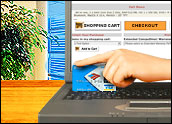
In the holiday selling season, the most frantic and exciting time of the year, it’s a good time to put aside your marketing plan and your email strategy and just blast out mailings to everyone you’ve ever had on any list you’ve ever put together. Right?
Wrong.
What we just described is a mistake that many e-marketers make, and it’s never a good idea. You have an email strategy in place, and it works well. Why abandon it for this one season? On the contrary: This is the time to follow your strategy even more carefully, because you just know that your customers are getting inundated with email right now — both wanted and unwanted — and it’s not going to take much for them to reach their tipping-point and say, “Enough!”
A good holiday strategy may well include increasing the frequency of your emailings — twice a week rather than once a week, for example — but no strategy involves changing your overall plan, reacting rather than acting, adding questionable addresses to your lists, or modifying the way you treat your customers.
The holiday season will tempt you to become more frantic in your marketing efforts to grab a piece of the lucrative seasonal pie. You deserve your part — but claim it in a way that is consistent with your plan.
Timing, Incentives and Learning From the Past
And what should that plan include? Consider the following:
- Start holiday promotions early! Consumers tend to wait for the last minute (and still want delivery by Christmas). There are only 20 business days between Thanksgiving and Christmas, so the earlier you can get your customers’ attention, the fewer potential shipping issues you’ll encounter.
- Provide incentives and create a sense of urgency for early action. There are dozens of ways to do this, and offering a special deal makes consumers quicker to act, especially in slower economic times.
- Go back and see what worked (and didn’t work) last year. If you have the data, base your evaluation of last year’s mailings on sales generated per email. Opens and clicks are important, but it ultimately boils down to how much money you made. There’s still time to track sales per email for this holiday season.
- Establish campaign objectives. Before you can design an email or decide to whom you want to mail, you need to decide what you want the campaign to accomplish. Campaigns designed to generate sales are very different from campaigns used for building brand equity, new name acquisition, etc. No matter what the desired outcome, the only way to know if a campaign is successful is to establish campaign metrics. I recommend tracking both email and result metrics.
- Review your database:
- Eliminate bad email addresses. This is one of the most important actions you can take. After complaints, the single most common reason for ISPs blocking your emails is bad email addresses (hard bounces).
- Review your list — any email address that hasn’t been mailed in the last six months is suspect. Create a separate list of these and send a special reactivation mailing to this group.
- Segment your database. Even if you don’t have a lot of demographic data about your customers, you can still significantly improve your response rate by creating separate segments and mailings for openers, clickers, purchasers, the top 10 percent, the bottom 20 percent, and so on.
- Review your landing pages. Make sure they’re relevant and that all the links work. Consumers who have opened their emails and clicked on a link to get to your landing page are your best prospects. A great landing page goes a long way to converting prospects into buyers. An irrelevant or poorly designed landing page will not only cost you current sales, it will cause these high-value prospects to think twice about opening the next email you send them.
- Develop your messaging strategy:
- Personalize your messages. Email provides a unique opportunity to communicate directly with your customers on a one-to-one basis.
- Make your messages clear, concise, and relevant.
- Have a visible call to action.
- Target your messaging by segment. This kind of targeting can have a significant impact on response rates.
- Review your creative:
- Is the look and feel consistent with the landing page, your website, and your brand?
- Is it clear, concise and easy to read?
- Will consumers know what to do when they open your email?
- Is it CAN-SPAM-compliant?
- Track and report: Make sure all of your tracking and reporting is set up.
Accentuate the Positive
A final note about campaign planning: It’s difficult to stay positive when the economy is bad, as it is yet again this fourth quarter. But you can still run a positive campaign by implementing some of these ideas:
ol.thisol { font-weight:bold } ol.thisol span {font-weight:normal }
- Look at the long term. This isn’t the time for immediate gratification or short-term ROI expectations. This is the time to build your branding for the future. Keep telling your customers about what they can look forward to as the weeks and months unwind. If you keep looking forward, they’ll look forward with you, too.
- Nurture your best customers. Make sure that they know that you appreciate their continued business. Send out an exclusive mailing that offers them something special, perhaps even free, as a reward for their loyalty. Tell them how much you appreciate them in a concrete way.
- Encourage newcomers. We all know about welcome messages and marketing to our newest customers; but this is a good time to go above and beyond for these folks. Some people subscribe out of curiosity; pique that curiosity some more. Offer as many opportunities for positive interaction with your brand as possible, and be creative about how to do it. A trivia quiz, a contest giveaway, anything that promises to give new customers something merely for their time and attention will help boost their familiarity with you and create future opportunities for revenue.
- Be creative in your creative. It’s time for a new angle on advertising your products and services. How can they be pitched to the changing needs of consumers? Advertising and email copy cannot stay static; you need to show your customers that you are there for them in different and special ways this year.
- Consider doing more specialized, targeted mailings. Take a look at the analytics you have on hand and see which segment of your list you can focus on for a few mailings. Craft creative and copy to show that segment that you understand their problems and how your product or service can provide a solution.
In all of this, keeping a positive tone is essential. It’s important to acknowledge customers’ difficulties — the world of advertising was founded on locating a problem and offering a solution to it — but you must do so while indicating that your product or service can in fact help them through those difficulties. And that’s what will get you through a great holiday selling season.
Neil M. Rosen is founder, president and CEO of eWayDirect.




































Wonderful pointers. Useful for non ecommerce services like image data entry services.
http://www.sunknowledge.com/image-data-entry-services.html